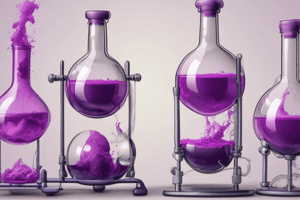Podcast
Questions and Answers
What is the advantage of using potassium permanganate in redox titrations?
What is the advantage of using potassium permanganate in redox titrations?
- It is a primary standard.
- It reacts incompletely.
- It is a strong reducing agent.
- It acts as its own indicator giving a clear colour change. (correct)
What is the purpose of adding dilute sulphuric acid to the ammonium iron (II) sulfate solution?
What is the purpose of adding dilute sulphuric acid to the ammonium iron (II) sulfate solution?
- To decrease the concentration of the solution
- To increase the rate of the reaction
- To prevent the iron (II) from reacting with the air to form iron (III) (correct)
- To enhance the colour change of the indicator
What is the result of adding potassium permanganate to a solution of ammonium iron (II) sulfate in acidic conditions?
What is the result of adding potassium permanganate to a solution of ammonium iron (II) sulfate in acidic conditions?
- The iron (II) is oxidized to iron (III)
- The manganese is reduced to Mn²⁺ (correct)
- The potassium is precipitated out of solution
- The solution remains unchanged
Why is potassium permanganate not used as a primary standard?
Why is potassium permanganate not used as a primary standard?
What is the importance of using deionised water in the preparation of the ammonium iron (II) sulfate solution?
What is the importance of using deionised water in the preparation of the ammonium iron (II) sulfate solution?
What is the oxidation state of manganese in potassium permanganate?
What is the oxidation state of manganese in potassium permanganate?
What is the purpose of adding nitric acid to the potassium permanganate solution?
What is the purpose of adding nitric acid to the potassium permanganate solution?
What is the colour of the manganese in the +7 oxidation state?
What is the colour of the manganese in the +7 oxidation state?
Why is hydrochloric acid not used to prevent the formation of an intermediate oxidation state in potassium permanganate titrations?
Why is hydrochloric acid not used to prevent the formation of an intermediate oxidation state in potassium permanganate titrations?
What is the result of the reaction between potassium permanganate and ammonium iron (II) sulfate in acidic conditions?
What is the result of the reaction between potassium permanganate and ammonium iron (II) sulfate in acidic conditions?
Flashcards are hidden until you start studying
Study Notes
Potassium Permanganate in Redox Titrations
- Potassium Permanganate (KMnO₄) is a useful oxidizing agent in redox titrations.
- It has the advantages of reacting completely and acting as its own indicator, giving a clear color change from purple to colorless.
Advantages and Disadvantages
- The advantages of KMnO₄ include its complete reaction and ability to act as its own indicator.
- The disadvantages include its instability and need for standardization against a standard solution of ammonium iron (II) sulfate prior to titration.
Standardization of Potassium Permanganate
- Ammonium iron (II) sulfate is used as a primary standard for standardizing potassium permanganate.
- The standard solution of ammonium iron (II) sulfate is prepared by weighing and diluting it in dilute sulfuric acid.
- The acid is added to prevent the iron (II) from reacting with air to form iron (III).
Preparation of Ammonium Iron (II) Sulfate Solution
- Weigh the required amount of ammonium iron (II) sulfate.
- Wash the powder into a beaker with dilute sulfuric acid.
- Stir well to dissolve.
- Pour the solution into a volumetric flask.
- Rinse the stirring rod and beaker with deionized water, adding the rinsings to the flask.
- Add water to the flask to bring the bottom of the meniscus to the mark.
Potassium Permanganate Characteristics
- Potassium Permanganate contains Mn in the +7 oxidation state, which is purple in color.
- In acidic conditions, Mn is reduced completely to the +2 oxidation state, resulting in a colorless solution.
- Without acidic conditions, an intermediate oxidation state of +4 is reached, resulting in a brown color.
Importance of Acidic Conditions
- Dilute sulfuric acid is added to the KMnO₄ solution to maintain acidic conditions.
- HCl cannot be used as it reacts with KMnO₄.
- Nitric acid cannot be used as it is a strong oxidizing agent itself.
- A fresh solution of potassium permanganate must be prepared just before titrating, as it reacts with both water and sunlight when in solution.
Studying That Suits You
Use AI to generate personalized quizzes and flashcards to suit your learning preferences.




